UPSC GS 1
Canary Islands
- News: Seven human traffickers accused of killing four migrants during a sea crossing to the Canary Islands have been arrested.
- The Canary Islands:
-
- The Canary Islands are a Spanish archipelago situated approximately 62 miles west of Morocco.
- They are classified as one of the European Union’s outermost regions, showcasing unique geographical and cultural characteristics.
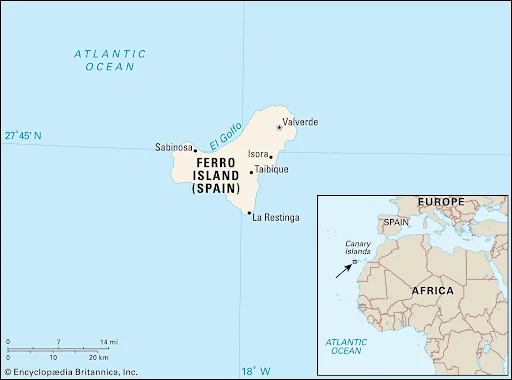
- Main Islands:
-
- The archipelago comprises seven major islands: Lanzarote, Fuerteventura, Gran Canaria, Tenerife, La Gomera, La Palma, and El Hierro.
- Climate and Oceanic Influence:
- The islands enjoy a subtropical climate with warm temperatures and minimal seasonal fluctuations.
- The Canary Current, a cold ocean current along Africa’s northwest coast, affects the region’s climate.
- This current contributes to the arid conditions of the nearby Sahara Desert and creates challenging sea conditions.
- Gateway to Europe:
- The Canary Islands serve as a transit point for migrants attempting to reach mainland Europe.
- The journey to the islands is perilous due to several factors:
- Strong ocean currents.
- Overcrowded and inadequately equipped boats.
- Harsh and unpredictable weather conditions.
- Definition of Archipelago:
- An archipelago refers to a cluster or chain of islands located close to each other in a body of water, such as a sea, ocean, lake, or river.
- These islands often form through volcanic activity, tectonic movements, or sediment accumulation.
UPSC GS 2
JIGYASA Program
- News: The Scientific Aptitude Assessment Exercise under CSIR’s JIGYASA program was conducted online on 20December 2024 in which the students gathered in each of 37 constituents’ laboratories of CSIR and took part in the big scientific demonstration and experiment.
- Launch and Background:
-
- The JIGYASA program was launched in 2017 by the Council of Scientific & Industrial Research (CSIR).
- It was introduced during the Platinum Jubilee year of CSIR and is also referred to as the CSIR Jigyasa Program.
- The initiative is part of the Scientific Social Responsibility (SSR), aiming to foster curiosity and a scientific mindset among students.
- Objective:
-
- The main aim of the Jigyasa program is to extend classroom learning by incorporating research laboratory-based learning for school students.
- The program focuses on enhancing the quality of education with research-based, value-added knowledge in science.
- Collaborations: To achieve its goals, the program partners with various institutions, including:
- Kendriya Vidyalayas (KVs)
- Navodaya Vidyalayas (NVS)
- Karnataka State S&T Academy (KSTA)
- Atal Innovation Mission (AIM)
- NITI Aayog, among others.
- Target Audience:
- The Jigyasa program is designed for students in the age group of 11-18 years (standards VI to XII), particularly those interested in exploring subjects such as Science, Mathematics, Biology, and IT.
- The program offers a Virtual Lab platform where students can engage in various scientific activities guided by experienced researchers and faculty members.
Read also: Ken-Betwa River Linking Project: Key Facts for UPSC Preparation
National Rainfed Areas Authority (NRAA)
- News: National Rainfed Areas Authority (NRAA) was established to support rainfed areas by analyzing investment types by different states and schemes.
- Establishment and Purpose:
- The National Rainfed Area Authority (NRAA) was established in 2006 as an expert body.
- It focuses on providing valuable knowledge inputs to support the upgradation and management of the country’s dryland and rainfed agriculture.
- Organizational Structure:
- Two-tier Structure: The NRAA operates with a two-tier structure comprising the Governing Board and the Executive Committee.
- Governing Board:
- Responsible for providing leadership and coordinating the implementation of programs.
- Chaired by the Union Agriculture Minister and co-chaired by the Union Minister of Rural Development.
- Executive Committee:
- Consists of technical experts and representatives from various stakeholder Ministries.
- Headed by a full-time Chief Executive Officer (CEO), who is a recognized expert in the subject area.
- The CEO is supported by five full-time technical experts.
- Mandate and Focus Areas:
- The NRAA’s main objective is to work on water conservation and facilitate sustainable development in rainfed areas.
- The focus includes the adoption of appropriate farming practices and livelihood systems.
- Special emphasis is placed on addressing issues concerning landless and marginal farmers, who make up the majority of the population in rainfed regions.
- Nodal Ministry:
-
- The Ministry of Agriculture and Farmers Welfare serves as the nodal ministry for the NRAA’s activities.
- The NRAA operates out of Delhi and is serviced by the Ministry of Agriculture.
UPSC GS 3
Household Consumption Expenditure Survey (HCES)
- News: India’s average household consumption spending on a per capita basis rose about 3.5% in real terms through August 2023 to July 2024 from a year ago, as per the Household Consumption Expenditure Survey (HCES).
- Household Consumption Expenditure Survey (HCES)
- Purpose: The survey collects detailed information on household consumption and expenditure on various goods and services.
- Significance: It helps analyze economic trends, determine poverty, inequality, and social exclusion, and update the basket and weights for calculating the Consumer Price Index (CPI).
- Key Indicator: The Monthly Per Capita Consumption Expenditure (MPCE) derived from this survey is the main metric for analytical purposes.
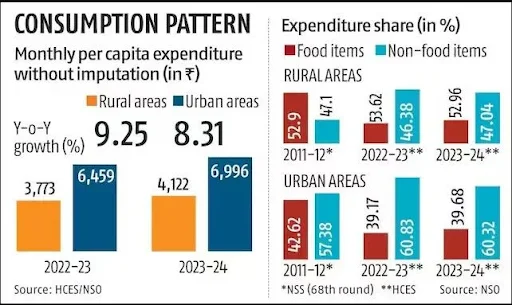
- Methodology: MPCE Estimates: In both HCES 2022-23 and HCES 2023-24, two sets of MPCE estimates were generated:
- Excluding imputed values for items received free of cost by households through social welfare programs.
- Including imputed values for such items.
- Conducting Authority: The survey is carried out by the National Sample Survey Office (NSSO), under the Ministry of Statistics and Programme Implementation (MoSPI).
- Key Findings of HCES 2023-24
- Increase in MPCE: The average MPCE (excluding imputation) in 2023-24 rose by 9% in rural areas and 8% in urban areas compared to 2022-23.
- Urban-Rural MPCE Gap: The urban-rural gap in MPCE decreased to 71% in 2022-23, further narrowing to 70% in 2023-24, reflecting robust rural consumption growth.
- Growth in MPCE by Population Segment: The largest increase in average MPCE between 2022-23 and 2023-24 was observed in the bottom 5–10% of the population in both rural and urban areas.
- Spending Trends:
- Non-food items remained the primary contributors to household average monthly expenditure in 2023-24, consistent with the trend in 2022-23.
- Among food items, beverages, processed foods, and refreshments accounted for the highest share of expenditure in rural and urban households.
- Major non-food expenses included conveyance, clothing, bedding, footwear, entertainment, and durable goods.
- Decline in Consumption Inequality: Consumption inequality declined in both rural and urban areas:
- Gini coefficient for rural areas reduced from 0.266 in 2022-23 to 0.237 in 2023-24.
- Gini coefficient for urban areas decreased from 0.314 in 2022-23 to 0.284 in 2023-24.
Sea Otters
- News: Sea otters are devouring thousands of green crabs — an invasive species native to Europe — at the Elkhorn Slough National Estuarine Research Reserve in California, helping save the ecosystem of the West Coast of the United States.
- Taxonomy: Sea otters belong to the weasel family and are fully aquatic mammals.
- Habitat:
- Found along the Pacific Ocean coasts, including North America (from Alaska to California) and parts of Asia (Russia and Japan).
- While they spend most of their time in the water, they occasionally come ashore to rest or sleep.
- Physical Features:
- Equipped with webbed feet and water-repellent fur that keeps them dry and warm.
- Their nostrils and ears close when submerged in water, aiding aquatic adaptation.
- Unlike other marine mammals, they lack a blubber layer for insulation and rely on a high metabolism to stay warm.
- Diet:
- Carnivorous by nature, they feed on sea urchins, crabs, mollusks, clams, and fish.
- Their significant appetite helps them consume large amounts daily to sustain body heat.
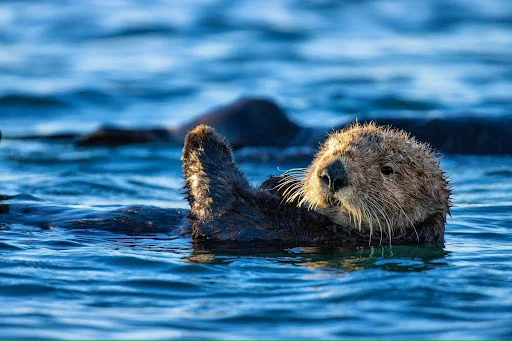
- Ecological Importance:
-
- Serve as a keystone species in kelp forest ecosystems, where they regulate sea urchin populations that can otherwise damage kelp forests.
- Their presence supports biodiversity and ensures the stability of marine ecosystems.
- Conservation Status:
- Classified as Endangered by the International Union for Conservation of Nature (IUCN).
- Green Crab (Portunus sanguinolentus):
- Definition:
- Also known as the shore crab or green shore crab, it is recognized as one of the top 100 “world’s worst alien invasive species.”
- Habitat:
- Native to the Atlantic Ocean and Baltic Sea, it has spread to regions like Australia, South America, and South Africa.
- Physical Characteristics:
- The carapace width reaches about 90 mm at maturity.
- Colours vary from green to brown, grey, and red, with red crabs resulting from delayed moulting.
- Red crabs are generally more aggressive than other colour variants.
- Diet:
- The green crab feeds on small crustaceans, molluscs, and worms.
- Ecological Impact:
- Damages seagrass beds, which serve as essential habitats for marine species.
- Overexploits prey species, disrupting the balance of native ecosystems.
- Competes with native species for resources like food and habitat, further threatening biodiversity.
Siang Upper Multipurpose Project (SUMP)
- News: Under the shadow of China’s plan to build the world’s largest dam, India is pushing for a counter project in Arunachal Pradesh.
- Definition:
- The Upper Siang Hydropower Project is a proposed 11,000 MW power plant on the Siang River in the Upper Siang district of Arunachal Pradesh.
- The Siang River, revered locally as Aane Siang (Mother Siang), forms the upper course of the Brahmaputra River.
- The project is seen as a strategic response to China’s proposed 60,000 MW super dam on the Yarlung Tsangpo (Brahmaputra) in Tibet’s Medog County.

- Key Features:
- Developers: National Hydroelectric Power Corporation (NHPC) and North Eastern Electric Power Corporation (NEEPCO).
- Pre-Feasibility Report (December 2022):
- Installed Capacity: 11,000 MW.
- Reservoir Storage: 9 billion cubic meters (BCM).
- Estimated Cost: ₹1,13,000 crore.
- The project area is home to the Adi Tribe, who share a deep cultural and livelihood connection with the Siang River.
- Local agriculture: The community practices pani kheti (settled farming along riverbanks) due to the limitations posed by the hilly terrain.
- The Adi Tribe
-
- The Adi Tribe speaks Tibeto-Burman languages and traces its ancestry to southern China, migrating in the 16th century.
- They excel in crafting items using cane and bamboo, showcasing unique craftsmanship.
- Solung: A harvest festival involving rituals and animal sacrifices.
- Aran: Celebrated as a hunting festival.
- Motor or Pator System: A traditional practice where villages undergo a ritual lockdown to locate wild herbs during epidemics, reflecting their deep understanding of nature.
Biodiversity Credit
- News: The voluntary biodiversity credit market, a mechanism where private companies fund biodiversity conservation and restoration projects, has been touted as a potential game-changer.
- Definition:
- Biodiversity credits are financial instruments that can be verified, quantified, and traded.
- They reward efforts to conserve and restore biodiversity, focusing on land or ocean-based ecosystems over a specific timeframe.
- The World Economic Forum describes them as a mechanism to link financial incentives with biodiversity outcomes.
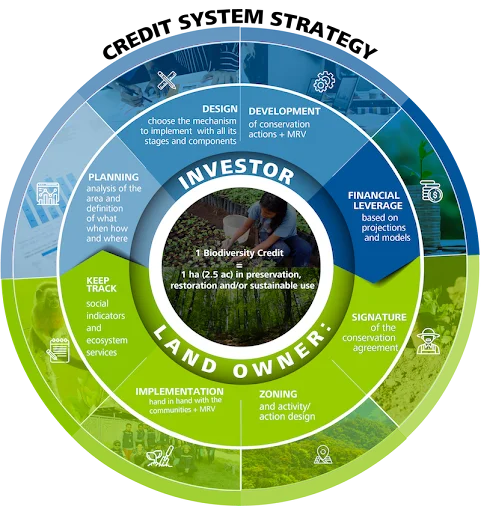
- Objective:
- Biodiversity credits aim to serve as innovative financing tools to attract private sector investments in biodiversity conservation and restoration.
- They aim to generate measurable positive outcomes for nature, aligning with the targets set under the Kunming-Montreal Global Biodiversity Framework (KMGBF).
- Mechanism:
- These credits function similarly to carbon markets by selling credits and using the proceeds for biodiversity-related initiatives.
- They are created by various entities, such as non-profits, governments, landowners, or corporations.
- Private companies purchase these credits to fulfill their biodiversity goals and commitments.
- Examples of Biodiversity Credit Schemes:
- ValueNature
- Terrasos
- CreditNature
- GreenCollar
- Market Value: According to the World Economic Forum:
-
- The biodiversity credit market currently stands at $8 million.
- It is projected to grow to $2 billion by 2030 and reach $69 billion by 2050.
- Biodiversity Credit Alliance:
- A voluntary global alliance established to support the Kunming-Montreal Global Biodiversity Framework.
- Focuses specifically on implementing Targets 19(c) and (d), which encourage private sector investments in biodiversity using biodiversity credits.
- Launch and Mission:
- Introduced during the 15th Conference of Parties to the UN Convention on Biological Diversity in 2022.
- Its mission is to establish a biodiversity credit market by creating a framework of high-level, scientifically grounded principles.
Coringa Wildlife Sanctuary
- News: The Wildlife Institute of India in Dehradun is launching India’s inaugural Fishing Cat Collaring Project at Coringa Wildlife Sanctuary.
- Coringa Wildlife Sanctuary:
- Location:
- Coringa Wildlife Sanctuary is located in the Godavari estuary in Kakinada district, Andhra Pradesh.
- The sanctuary lies at the confluence of the Coringa River and the Bay of Bengal.
- “Hope Island” blocks the direct confluence of the sea and the Godavari, which creates unique tidal and backwater conditions.
- About 40% of the sanctuary consists of sea-backwaters, while the remainder is made up of intermingled creeks that are inundated with tidal waters.
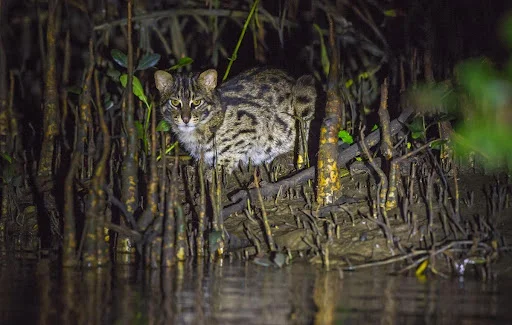
- Vegetation:
- The sanctuary is home to extensive mangrove forests and dry deciduous tropical forests.
- It has the second-largest stretch of mangrove forests in India.
- Flora and Fauna:
- Flora: The sanctuary hosts mangrove species such as Rhizophora spp., Avicennia spp., and Sonneratia spp.
- Fauna: It is home to endangered species like the Smooth Indian Otter, Fishing Cat, and Jackal.
- Birdlife: Mangrove habitats support bird species such as the Black-capped Kingfisher, Brahminy Kite, Sea Gulls, Reef Heron, and Sandpipers.
- The coastal area serves as a breeding ground for Olive Ridley turtles.
- Fishing Cat: Key Facts
- Description:
- The Fishing Cat (Prionailurus viverrinus) is a medium-sized wild cat known for its strong swimming abilities.
- It is a solitary, nocturnal hunter, often resting during the day in dense vegetation and hunting at night, primarily in aquatic habitats.
- They are adept swimmers and can swim over large distances while pursuing fish.
- Physical Appearance:
- Fishing cats are stocky with short legs and a short tail.
- They have a round yet elongated face, and females are typically smaller than males.
- Habitat:
- Fishing Cats prefer wetland habitats such as swamps, marshes, oxbow lakes, reed beds, tidal creeks, and mangrove forests.
- Distribution:
- Fishing Cats are found across Southeast Asia, including Sri Lanka, parts of Pakistan, and extending to western India, southern China, Java, and Sumatra.
- Conservation Status:
- IUCN Red List: The Fishing Cat is classified as Vulnerable.
- CITES: It is listed in Appendix II of the Convention on International Trade in Endangered Species (CITES).
- Wildlife Protection Act, 1972: The species is listed under Schedule I, which provides it with the highest level of protection.
- Fishing Cat Collaring Project:
-
- The Wildlife Institute of India-Dehradun is set to implement India’s first Fishing Cat Collaring Project at Coringa Wildlife Sanctuary, where the species is known to thrive.
Heliobacter Pylori
- News: Researchers have found a way to develop FELUDA as a point-of-care diagnostic service at a minimal cost for detection of H. pylori and its mutations in dyspeptic patients from rural areas of India, with minimal or no access to diagnostic laboratories.
- About Helicobacter Pylori (H. pylori)
- General Information:
- H. pylori is a type of bacteria commonly found in the digestive tract, particularly attacking the stomach lining.
- This bacterium is well-adapted to live in the acidic environment of the stomach.
- H. pylori infection often begins during childhood and can affect more than 43% of the global population.

- Health Impact:
- Although infections are typically harmless, H. pylori is the primary cause of peptic ulcers in the stomach and small intestine.
- It is linked to several gastrointestinal disorders, including:
- Peptic ulcers
- Gastritis
- Dyspepsia
- Gastric cancer
- Survival Mechanism:
- H. pylori can alter the surrounding environment by reducing stomach acidity, which helps it survive in the harsh conditions.
- Its spiral shape allows it to penetrate the stomach lining, where it is protected by mucus, making it difficult for the body’s immune system to detect and eliminate it.
- Symptoms of Infection:
- When symptoms appear, they are often associated with gastritis or a peptic ulcer and can include:
- Aching or burning stomach pain, particularly when the stomach is empty
- Nausea
- Loss of appetite
- Unintended weight loss
- Treatment:
-
- The treatment for H. pylori infection typically involves a combination of antibiotics and a proton-pump inhibitor (PPI) that reduces stomach acid.
- This is often referred to as triple therapy, and it is administered for a period of up to 14 days to effectively eradicate the infection.

